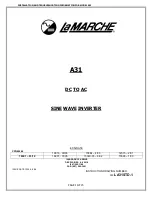
13
11.
Using a High Speed HDMI® Cable (not included), plug one end into the 2-HDMI
INPUT, then plug the other end into the HDMI output on your HDMI video source
device.
12.
Using a High Speed HDMI® Cable (not included), plug one end into the 3-HDMI
INPUT, then plug the other end into the HDMI output on your HDMI video source
device.
13.
Using a DisplayPort cable (not included), plug one end into the 4-DP INPUT, then
plug the other end into the DisplayPort output on your DisplayPort video source
device.
14.
Using a 3.5mm audio cable, plug one end into the 3.5mm audio jack associated with
the 4-DP INPUT, then plug the other end into the audio output on your DisplayPort
video source device.
15.
Using the included VGA cable, plug one end into the 5-VGA INPUT, then plug the
other end into the VGA output on your VGA video source device (e.g., computer).
Alternatively, plug the included Video Cable into the 5-VGA INPUT, then plug the
red, green, and blue RCA plugs into the corresponding Component (YPbPr) RCA
jacks on your Component video source device or plug the red RCA plug into the
video RCA jack on your Composite (CVBS) video source device.
16.
Using a 3.5mm audio cable (not included), plug one end into the 3.5mm audio jack
associated with the 5-VGA INPUT, then plug the other end into the 3.5mm audio
output on your VGA source device. Alternatively, using a 3.5mm to stereo RCA cable
(not included), plug the 3.5mm end into the 3.5mm audio jack associated with the 5-
VGA INPUT, then plug the stereo RCA jacks into the stereo RCA outputs on your
Component (YPbPr) or Composite (CVBS) video source device.
17.
Using a Cat6 Ethernet cable (not included), plug one end into the HDBT RJ45 jack on
the HDBaseT™ receiver, then plug the other end into the HDBT OUTPUT on the
scaler/switch.
18.
(Optional) If you want to control the scaler/switch using your computer and third
party RS232 control software, plug 3-pin terminal end of the included RS232 cable
into the RS232 CONTROL terminal on the scaler/switch, then plug the DB9
connector into one of your computer's COM ports.














































